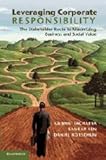Leveraging corporate responsibility : the stakeholder route to maximizing business and social value / C.B. Bhattacharya, Sankar Sen, Daniel Korschun.
Material type: TextPublication details: Cambridge ; New York : Cambridge University Press, 2011.Description: xiii, 326 p. : ill. ; 24 cmISBN:
TextPublication details: Cambridge ; New York : Cambridge University Press, 2011.Description: xiii, 326 p. : ill. ; 24 cmISBN: - 9781107009172 (hbk.)
- 9781107401525 (pbk.)
- 658.408/BHA
- BUS008000
| Item type | Current library | Collection | Call number | Status | Date due | Barcode |
|---|---|---|---|---|---|---|
 Books
Books
|
Symbiosis Centre for Management Studies, Vimannagar General Stacks | Text Book | 658.408/BHA (Browse shelf(Opens below)) | Not For Loan | SCMSUGV-B-14915 |
Includes bibliographical references and index.
"The corporate social and environmental responsibility movement, known more generally as corporate responsibility (CR), shows little sign of waning. Almost all large corporations now run some form of corporate responsibility program. Despite this widespread belief that CR can simultaneously improve societal welfare and corporate performance, most companies are largely in the dark when it comes to understanding how their stakeholders think and feel about these programs. This book argues that all companies must understand how and why stakeholders react to such information about companies and their actions. It examines the two most important stakeholder groups to companies - consumers and employees - to comprehend why, when and how they react to CR. Armed with this insight, it shows how companies can maximize the value of their CR initiatives by fostering strong stakeholder relationships to develop, implement and evaluate compelling social responsibility programs that generate value for both the company and its stakeholders"--
"He long and winding road to CR value Corporate Responsibility (CR) and you On September 5, 2007, the Buddhist monks of Pakokku, Myan-mar joined the citizen protests that erupted in that impoverished country in August of that year. The uprising was triggered by a long-simmering array of discontents ranging from high commodity prices to human rights abuses, including the long-term detention of pro-democracy leader Aung San Suu Kyi. The ruling military government in Myanmar, in power since 1962, took action to quell the protests. A few days after the monks joined the protests, troops fired on protesters in a crackdown that left at least ten people dead by the government's account (opposition groups put the fatalities at around 200). Independent reports suggest that several monks were beaten and killed. "--







There are no comments on this title.